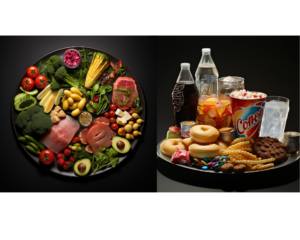
Opportunity + Perseverance = Success
Quick Fixes Work
We’ve all seen those flashy headlines promising “Lose 10 Pounds in 10 Days!” or “Miracle Pill Melts Fat Away.” It’s tempting to think that a quick fix is just around the corner, waiting to make all your weight loss dreams come true. But remember, if it sounds too good to be true, it probably is. These “quick fixes” often rely on severely limiting calories, cutting out entire food groups, or using unregulated supplements, which can harm your health in the long run.
The uplifting truth is that achieving sustainable weight loss is not just a dream; it’s entirely within your reach! It’s not about finding a magic bullet; it’s about creating a lifestyle that incorporates balanced eating and regular exercise. You may not lose 10 pounds in 10 days, but losing 1-2 pounds a week is both attainable and healthy. And unlike the quick fixes, you’ll set yourself up for long-term success.
Exercise is the Key
Exercise is fantastic for you—there’s no doubt about it. It improves cardiovascular health, boosts your mood, and can even help you live longer. Many people, inspired by these benefits, fully invest in the notion that exercise alone will take care of their weight loss goals. But while it may be a crucial part of a healthy lifestyle, exercise alone is often insufficient for significant weight loss. This is especially true if your diet is still high in calories and low in nutrients.
Don’t be discouraged, though! The key is to pair regular physical activity with a balanced diet. Here’s an inspiring fact: Exercise not only torches calories and sculpts muscles, but it also elevates your overall sense of well-being! Still, those benefits are best realized when they’re part of a broader approach that includes good nutritional choices. So don’t give up on exercise—ensure you’re also paying attention to your eating. The exciting news is that by harmoniously blending these two elements, you dramatically increase your chances of not just reaching but also sustaining your weight loss goals!
Calories are Equal
The idea that “a calorie is a calorie” simplifies a rather complex topic. This viewpoint suggests that weight loss is merely a numbers game: eat fewer calories than you burn, and you’ll lose weight. Here’s an enlightening perspective: While the basic principle of calories in versus calories out holds merit, it’s crucial to recognize that not all calories offer the same nutritional value or satisfaction—meaning you have the power to make smarter, more fulfilling choices! For example, 200 calories of vegetables will not have the same impact on your body—or your hunger—as 200 calories of sugary soda.
Here’s the uplifting part: once you understand this, making smart, sustainable choices becomes easier. When you focus on nutrient-dense foods like fruits, vegetables, lean proteins, and whole grains, you’ll feel fuller for longer and have more energy. These foods offer vitamins, minerals, and fiber your body needs, making it easier to stick to a reasonable calorie count. So, don’t just count calories; make the calories count by choosing foods that nourish you.
Low Fat = Weight Loss
Once upon a time, “low-fat” was the golden phrase in the dieting world. People believed cutting fat from their diets was the ticket to quick and easy weight loss. The uplifting takeaway is that not all fats are the same—some are actually beneficial and essential for our body’s optimal functioning! Essential fatty acids in foods like fish, avocados, and nuts are crucial for brain function, hormone production, and the absorption of specific vitamins. Cutting out all fats can deprive us of these benefits.
Here’s a cheerful insight: Grasping the importance of healthy fats in a well-rounded diet can actually add joy and satisfaction to your weight loss adventure. By thoughtfully incorporating moderate portions of nutritious fats into your meals, you’re more likely to feel satiated for extended periods, diminishing the allure of sugary treats or excessive portions! So go ahead and enjoy some avocado on your toast or a handful of almonds as a snack. Incorporating healthy fats can enhance your meals’ flavor and contribute to a well-rounded, sustainable approach to weight loss.
Skipping Meals Will Help
You might think skipping meals here and there will fast-track your weight loss efforts. The logic seems straightforward: fewer meals mean fewer calories consumed, right? Well, it’s not that simple. Skipping meals can lead to decreased metabolism, increased hunger, and a higher likelihood of overeating later. Essentially, your body switches into “survival mode,” conserving energy because it’s unsure when it will receive nutrients next.
But don’t worry—there’s a much more enjoyable and practical approach. Eating balanced meals at regular intervals sets the stage for sustainable weight loss by keeping your metabolism active and your energy levels stable. You don’t have to fight against your body’s natural processes; you can work with them! A regular eating schedule with a variety of nutrients supports your body’s functions. The wonderful news is that feeling satiated throughout your day empowers you to effortlessly sustain a calorie deficit, all without experiencing a sense of deprivation!
Weight Loss is Linear
Ah, the ups and downs of the scale—quite literally. It’s a common belief that weight loss should be a straightforward, downward trajectory. However, weight can fluctuate for various reasons, such as water retention, muscle gain, and hormonal changes. This can lead to frustration if you’re expecting to see the number on the scale decrease consistently.
Here’s the positive flipside: Weight fluctuations are a normal part of any journey to better health, and they certainly don’t mean you’re failing. Gaining muscle mass through exercise can even lead to temporary weight gain or a plateau. Still, muscle is more metabolically active than fat, meaning you’ll burn more calories at rest in the long run. So, rather than solely relying on the scale, consider other ways to track your progress, like how your clothes fit, increases in physical stamina, or even positive changes in your mood and energy levels. These can often be more reliable indicators that you’re moving in the right direction, helping you stay motivated and optimistic.
Carbs are the Enemy
The “war on carbs” has been a prominent theme in the dieting world for quite some time. Low-carb diets like Keto and Atkins have led to the belief that carbohydrates are the culprits behind weight gain. While it’s true that excessive consumption of simple carbs—like sugary snacks and drinks—can contribute to weight gain, it’s misleading to label all carbs as bad. Here’s a reason to be optimistic: Complex carbohydrates, abundant in whole grains, fruits, and vegetables, are your body’s powerhouse for sustained energy and a treasure trove of essential nutrients!
The brighter side is that when you distinguish between good and bad carbs, you empower yourself to make healthier choices that support sustainable weight loss. Here’s a delightful fact: Whole grains, fruits, and vegetables not only fuel your daily activities but also come richly packed with fiber, vitamins, and minerals to elevate your overall well-being! Instead of fearing carbs, embrace the ones that offer nutritional benefits and avoid those that are merely empty calories. In doing so, you’re taking a balanced approach that will likely yield long-lasting results.
Detox Cleanses
The idea of a “detox cleanse” often promises a fresh start, a quick “reset” that purges your body of toxins and jump-starts your weight loss journey. While this sounds appealing, the truth is that your body is already equipped with its own natural detoxification systems—namely, the liver and kidneys. These organs work around the clock to filter out impurities, making most detox cleanses unnecessary and, in some cases, even harmful by depriving your body of essential nutrients.
Now for the uplifting part: You don’t need a drastic cleanse to start making healthier choices. Your body is remarkably resilient and capable of detoxification without extreme diets or expensive supplements. The uplifting reality is that by embracing a balanced diet abundant in fruits, vegetables, lean proteins, and whole grains, you’re already championing your body’s innate detoxifying functions! So, rather than looking for a quick fix, celebrate the incredible machine that is your body by nourishing it with the nutrients it needs. This is not only a more sustainable approach but also one that respects and harnesses your body’s natural abilities.
Spot Reduction Works
Ah, the enticing notion of spot reduction—a captivating yet misleading idea that suggests you can zero in on fat loss in particular areas through targeted exercises! Wouldn’t it be wonderful if a few hundred crunches could eliminate belly fat or if leg lifts could instantly tone your thighs? Unfortunately, the body doesn’t work that way. Fat loss happens throughout the body, not just in the areas where you’re exercising. When you burn more calories than you consume, your body will decide where to pull that fat from, and it’s usually not just from the spots you’re targeting.
Here comes the silver lining: Even though spot reduction is a myth, that doesn’t mean targeted exercises are useless. On the contrary, they are crucial for building muscle and improving muscle tone. And remember, more muscle means a faster metabolism, which helps you burn calories more efficiently. So, do those crunches, leg lifts, or arm curls—not because they’ll remove fat from specific areas, but because they’ll contribute to your overall fitness and help you achieve a leaner, stronger body.
BMI is the Best Indicator
Body Mass Index, or BMI, has long been touted as the go-to metric for assessing one’s health and weight status. It’s a simple formula based on height and weight, and many people consider it gospel. However, BMI does not consider muscle mass, overall body composition, or fat distribution. In other words, it’s entirely possible to have a BMI that categorizes you as “overweight” or “obese” even if you’re in good health and have a high muscle-to-fat ratio.
Now for the optimistic twist: the limitations of BMI mean that you have a broader, more nuanced set of tools to assess your progress. Metrics like waist circumference, body fat percentage, or even simpler indicators like how your clothes fit can offer a fuller picture of your health. Best of all, these alternative metrics can be empowering. These alternative metrics offer an inspiring and precise snapshot of your dedicated efforts, empowering you to remain steadfast in your weight loss journey while celebrating your holistic progress!
And there we have it—a comprehensive look at common misconceptions that often plague the path to healthy, sustainable weight loss. The great news is that each myth we’ve dispelled opens the door to a more balanced, practical, and science-backed approach to achieving your health and fitness goals.


